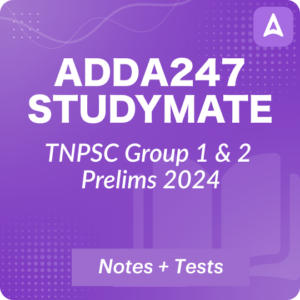TNPSC Samacheer Book Back Questions: ADDA 247 Tamil is giving you TNPSC Samacheer Book Back Questions Rural Life and Society MCQs for all competitive exams. Here you get Multiple Book Back Choice Questions and Answers. Here you will find all the important questions and answers that will help you increase your knowledge and move you toward fulfilling your goals. Study these TNPSC Book Back Questions MCQs and succeed in the exams.
Attend TNPSC Book Back Question Quiz Here
Choose the correct answer
Q1. Which system was called by different names like Jagirdari, Malguzari and Biswedari etc.?
(a) Mahalwari
(b) Ryotwari
(c) Zamindari
(d) None of these
S1.Ans.(d)
Sol.
- During the time of Lord Cornwallis, a ten years’ (decennial) settlement was introduced in 1793 and it was known Permanent Settlement.
- It was known by different names like Zamindari, Jagirdari, Malguzari and Biswedari.
Q2. Under which Governor General did the permanent settlement implemented in
Bengal.
(a) Lord Hastings
(b) Lord Cornwallis
(c) Lord Wellesley
(d) Lord Minto
S2.Ans.(b)
Sol.
- During the time of Lord Cornwallis, a ten years’ (decennial) settlement was introduced in 1793 and it was known as Permanent Settlement.
Q3. What was the Mahal in the Mahalwari system?
(a) House
(b) Land
(c) Village
(d) Palace
S3.Ans.(c)
Sol.
- Assessment of revenue was to be made on the basis of the produce of a Mahal or village
Q4. In which region was the Mahalwari system imposed?
(a) Maharashtra
(b) Madras
(c) Bengal
(d) Punjab
S4.Ans.(d)
Sol.
- Mahalwari system, a brain child of Holt Mackenzie was modified version of the Zamindari settlement introduced in the Ganga valley, the North-West Province, parts of the Central India and Punjab in 1822.
Q5. Who among the following Governors introduced the Mahalwari system?
(a) Lord Hastings
(b) Lord Cornwallis
(c) Lord Wellesley
(d) Lord William Bentinck
S5.Ans.(d)
Sol.
- Lord William Bentinck was to suggest radical changes in the Mahalwari system by the guidance of Robert Martins Bird in 1833.
Q6. In which region was the Ryotwari system not introduced by the British?
(a) Bombay
(b) Madras
(c) Bengal
(d) None of these
S6.Ans.(c)
Sol.
- Ryotwari system was introduced by Thomas Munro and Captain Read in 1820. Major areas of introduction of the Ryotwari system included Madras, Bombay, parts of Assam, and Coorg provinces of British India.
Q7. The Indigo revolt was led by whom?
(a) Mahatma Gandhi
(b)Keshab Chandra Roy
(c) DigambarBiswas and BishnuBiswas
(d) Sardar Vallabhbhai Patel
S7.Ans.(c)
Sol.
- Led by Digambar Biswas and Bishnu Charan Biswas, the ryots of Nadia district gave up indigo cultivation in September 1859
Q8. The Bardoli Satyagraha was led by whom?
(a) Sardar Vallabhbhai Patel
(b) Mahatma Gandhi
(c) DigambarBiswas
(d)Keshab Chandra Roy
S8.Ans.(a)
Sol.
- In 1928, the peasants of Bardoli (Gujarat) started their agitation under the leadership of Sardar Vallabhbhai Patel, in protest against the government’s proposal to increase land revenue by 30 percent.
II Fill in the Blanks
- ———————is the modified version of the Zamindari system. (Mahalwari system)
- The Mahalwari system was a Brain child of ———————.(Holt Mackenzie)
- The Indigo Revolt took place in———————.(Bengal)
- Moplah Rebellion was held in———————. (Malabar (Kerala))
- The Champaran Agrarian Act was passed in———————. (May 1918)
III
Q9.Match the following:
- Permanent Settlement–Madras
- Mahalwari Settlement–Misery of the Indigo cultivators
- Ryotwari System–North west province
- Nil Darban—Bengali
- Santhal Rebellion–First Peasant revolt
(a) 5 4 2 1 3
(b) 5 4 3 1 2
(c) 3 4 5 1 2
(d) 4 1 3 2 5
S9.Ans.(d)
Sol.4 1 3 2 5
IV State true or false
- Warren Hastings introduced quinquennial land settlement. true
- Ryotwari system was introduced by Thomas Munro. true
- Pabna revolt originated in the Yusufshahi pargana in Gujarat. false
- The Punjab land alienation Act was passed in 1918. false
V
Consider the following statement and tick (✓) the appropriate answer
Q10. Which of the following statements is not true about the Zamindari system?
(a) This settlement was introduced in 1793.
(b) The Zamindars became the owner of the land.
(c) This system secured a fixed stable income for the cultivators.
(d) This practice was applicable to the area of 19% of India.
S10.Ans.(c)
Sol.This system secured a fixed and stable income for the British Government.
Q11. Which of the following statement is correct about the Peasants revolt in India?
(a) The Santhal rebellion was held in Bengal.
(b) Dinabandhu Mitra wrote a drama called Nil Darban.
(c) The Deccan riots started from a village at Pune in 1873.
(d) The Moplah peasants rebellion was held in Tamil Nadu.
S11.Ans.(b)
Sol.
- The newspaper, Hindu Patriot brought to light the misery of the cultivators several times. Dinabandhu Mitra wrote a drama, Nil-Darpan, in Bengali with a view to draw the attention of the people and the government towards the misery of the indigo-cultivators
**************************************************************************
| Adda247 TamilNadu Home page | Click here |
| Official Website=Adda247 | Click here |




